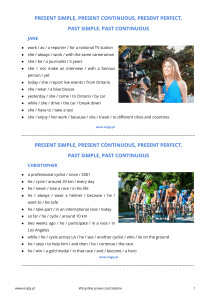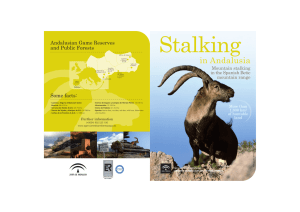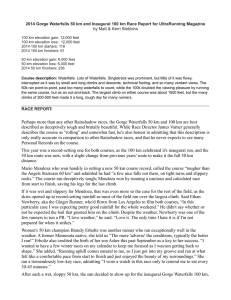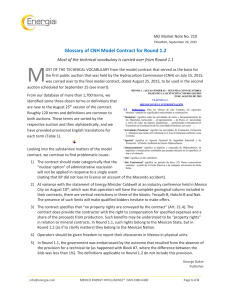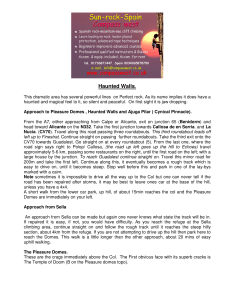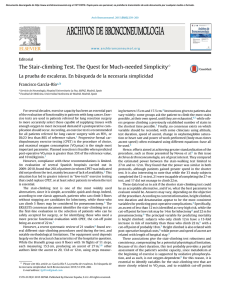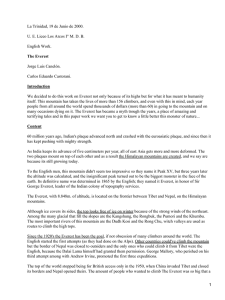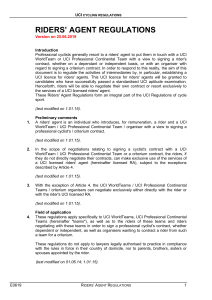Something about the name of this sportive hinted to
Anuncio
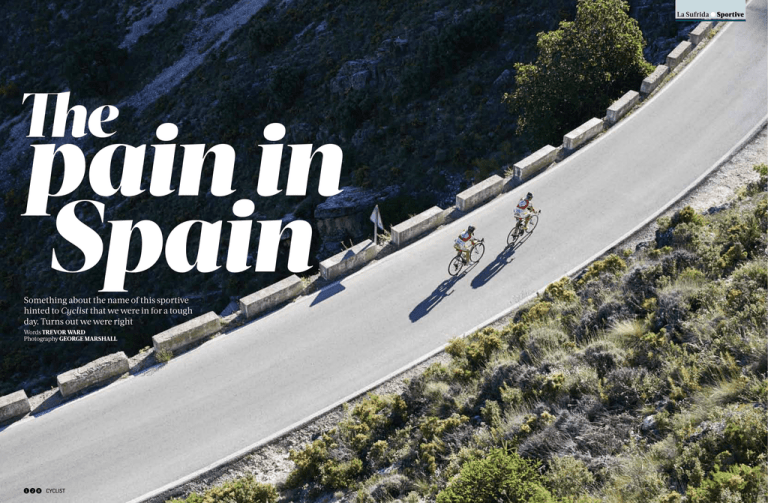
La Sufrida b Sportive The pain in Spain Something about the name of this sportive hinted to Cyclist that we were in for a tough day. Turns out we were right Words Trevor Ward Photography George Marshall 128 cyclist Sportive b La Sufrida A few days after completing La Sufrida in southern Spain, I found myself in a backstreet flamenco club listening to what could have been the soundtrack to the event. They call it cante jondo, or deep song, because it comes from the heart. The usual dramatic staples are unrequited love, stolen cattle or being stabbed in a fight over a card game. But as I listened to the singer, a woman who looked as though she regularly ate barbed wire for breakfast, I thought her lament perfectly captured all the emotions I’d felt during one of the toughest sportives in Europe. The first verse was surely about the pain of climbing ‘the Wall’ of Montecorto and wondering whether I’d ever see my loved ones again. This was followed by a plaintive wailing that could only be describing the designer of the sportive’s route, a soldier who had left the Spanish Legion to design a series of increasingly sadistic challenges for cyclists. Then a change in melody signalled the joyous but all-too-brief respite provided by the fast, sinuous descent of the A-374 Ronda bypass as it catapulted us into the final 50km and a stiff headwind all the way to the finish. Finally, a shift in tone paid tribute to the achievements of the finishers and the uniqueness of the trophy we each received: a piece of stone recycled from a local cemetery. Yes, I thought, as I enjoyed the hand-clapping and foot-stomping in Seville’s Peña del Nino de la Alfalfa (literally, ‘Club of the Kid of the Sprout’), La Sufrida would be the perfect subject for a cante jondo… P Every rider who finishes La Sufrida gets a trophy made from a lump of rock taken from the surrounding hills. They will have earned it ‘The PA system starts pumping out “Ride of the Valkyries”. If we didn’t know we were on the brink of an epic, we do now’ 130 cyclist The details Go on, you know you want to… What Granfondo La Sufrida Where El Gastor, near Ronda, Spain Next One 30th May 2015 Distance 196km or 124km Price €46 (€38 if you sign up before the end of December 2014). Includes t-shirt, trophy, post-ride beer and paella. Sign up lasufrida.net/web La Sufrida b Sportive ‘It’s easily the slickest and friendliest sportive I’ve entered. Oh, and the toughest’ P The masters of pain Oscar Pajares doesn’t look like a sadist. He looks far more like an absent-minded uncle who’s lost his reading glasses. But you wouldn’t mess with him. He’s a lieutenant colonel who spent 18 years in Spain’s equivalent of the French Foreign Legion. Now he competes in ultramarathons for fun, and in between he has spent the last 16 years designing increasingly challenging routes for La Sufrida. He reckons this year’s course, at 196km in length and with 4,700m of climbing, will be his best work yet. We meet him at registration on the 132 cyclist eve of the event. Only a handful of the 600 entrants are from outside Spain, 25 of them Brits, and Oscar is keen to make us feel as welcome as possible. He is accompanied by his co-conspirator, Oswald Rojano, who, in his baggy shorts and big spectacles, looks more like an overgrown Harry Potter than a bank manager from Seville. The impression they give is of having arranged a big family picnic rather than a challenge so brutal that 20% of the starters will not make it to the finish. The suffering starts in the pretty hilltop village of El Gastor, where The climb to the Puerto de las Palomas has an epic view of the El Gastor reservoir potted geraniums spill from the balconies and the scattering of bars are offering coffee and cabrillas – large snails – for breakfast. Shortly before 8am, the PA system starts pumping out Wagner’s ‘Ride of the Valkyries’ and a succession of rockets are set off. If we didn’t already know we were on the brink of something epic, we do now. My last training ride was a couple of days ago with Gary Williams, who runs Vamos Cycling holidays in the heart of Spain’s Alpujarras mountains. A veteran of several Sufridas (he finished second in the Masters 40s age group last year) his advice was succinct: ‘The first two climbs are the longest. Don’t try and keep up with everyone, just do them at your own pace, otherwise you won’t survive the distance.’ As if the distance and elevation aren’t fearsome enough, there are also strict cut-off times. The next nine hours or so are going to be a fine balancing act between keeping something in reserve and avoiding elimination at one of the regular checkpoints. Before the start, I scrutinise the route card more intensely than I’ve ever studied a piece of paper in my life. Knowing the distance between feed and drink stations, and where they are on the profile, could mean the difference between a comfortable day in the saddle or bonking halfway up a mountainside miles from the nearest pueblo. It soon becomes clear that despite the sadistic nature of the route, Oscar and Oswald have organised everything else to make the rider’s experience Above: A rare bit of shade from the Andalucian sun Left: With so many cyclists on the road, it was a day off for horses as relatively stress-free and enjoyable as possible. From the personalised entry pack – ‘Animo y Valor, Trevor!!’ (roughly, ‘Come on, you can do it!) – to the volunteers at the food and drink stations who rush to you with boxes full of sandwiches, energy bars and fruit so that you barely have to unclip from the pedals, it’s easily the slickest and friendliest sportive I’ve entered. Oh, and the toughest. On the up The first test comes after 18km: a 12km climb at an average gradient of 7% to Puerto de las Palomas. This climb may not reach the heights of the Alps or Pyrenees – a mere 1,200m, in fact – but its relentless switchbacks offer views that are no less spectacular. Below us the valley unfurls in an explosion of colour. It’s late spring in Andalucia and the wild flowers and jacaranda trees are in full bloom. A ribbon of Lycra with the faintest pink blur of spinning legs P cyclist 133 Sportive b La Sufrida ‘I think they’re shouting, “Animal! Animal!” at me. In fact it is “Animo!”’ Above: Riders near the top of the first climb to Puerto de las Palomas (Pass of the Pigeons) have plenty left in the tank – for now… The rider’s ride Fuji Gran Fondo 2.5 2014, approx £1,500, evanscycles.com I have only good things to say about this bike. We went to hell and back: nearly 10 hours in the saddle, up gruelling climbs and down challenging descents, and apart from shipping the chain at the top of the penultimate peak, it never let me down. The Gran Fondo 2.5 sits in Fuji’s ‘Endurance’ series, meaning it has the fairly relaxed geometry and long wheelbase of a cruiser rather than a racer, but that’s not to say it’s lethargic. I set it up on the side of comfort because I knew this ride was going to be long and tough. The carbon frame felt suitably light on the climbs, stiff on the descents, and compliant on the bumpy stuff. It certainly outshone its entry level pricetag, and the Shimano 105 groupset operated smoothly whether on the 23% ramp at the top of the Wall of Montecorto or on the gently rolling roads at the bottom. A cracking ride. 134 cyclist P trails back down to the whitewashed houses of Zahara and the sprawling, sparkling mass of the El Gastor reservoir. From the top, it’s a sweet, swift plunge to the town of Grazalema, and from there we emerge into a gently descending valley where I manage to piggyback between a succession of small groups. The roads aren’t closed, but are largely trafficfree, and police or volunteers are present at key junctions. I think I must look really impressive because they’re shouting, ‘Animal! Animal!’ at me as I hurtle by. In fact it is ‘Animo!’ (‘Come on!’) an encouragement they offer to every rider, not just the red-faced Englishman. By the time the road begins a steep, snaking descent towards the outskirts of Ubrique, the groups have thinned out to clusters of two or three riders. I arrive at El Bosque on my own and P La Sufrida b Sportive Right and below: The infamous Wall of Montecorto sees many riders walking, and Cyclist reverting to zigzag tactics (bottom left) ‘It’s the stuff of nightmares, with a maximum gradient of 24% on the lower section and 23% near the top’ P am momentarily confused when a marshal steps out into the road and waves me into a layby. It soon transpires this isn’t a random drug test but the start of the second climb, which will be timed. As we don’t have anything as sophisticated as timing chips, we have to have the number on our bikes clipped with an old-fashioned ticket punch before being recorded on a laptop. Only then are we released back onto the road to start the 14.5km haul, at an average gradient of 6%, to Puerto del Boyar. We’d all been content to spin gently up the first climb, but now that the clock is ticking, bigger gears are required. My legs feel good but I decide to err on the side of caution and I hold back at first. At the top of this climb there’ll still be over 100km to go, and I’m bracing myself for the most horrible part yet. Another Brit on the Wall The dreaded ‘Wall’ of Montecorto comes after 107km. It’s 4.8km long, and a large section of false flat in the middle lowers the average gradient to only 5%, but the gradients before and after that false flat are the stuff of nightmares, with a maximum of 24% on the lower section and 23% near the top just when you think it surely can’t get any worse. And of course it’s at this exact point, just as I have resorted to zigzagging across the width of the road, that the Harry Potter-like figure of Oswald appears – in a Seat hatchback, not on a broomstick – with Cyclist’s photographer, George, in tow. With Oswald shouting words of encouragement, George snaps away. The road is so steep he has time to change lenses, text his girlfriend and drink a can of Coke before I have completed the first zig and moved laboriously onto zag. 136 cyclist At last the road peaks and begins its equally steep downward trajectory, but even then there’s no respite. I spot a makeshift sign warning ‘Peligro’ (danger) just as the smooth road surface crumbles into a long stretch of rutted gravel. There’s a sharp left bend rushing towards me at unnerving velocity, but I don’t want to risk braking while I’m bouncing over such broken, loose terrain, so I wait until the very last minute, just as the smooth asphalt surface resumes. For a second it looks as though I don’t have enough road left and am going to overshoot the bend, but with some improvised repositioning of knees and hips I just manage to avoid calamity. Planet lonely The Wall of Montecorto has left me so traumatised I’m tempted to join the riders who are doing the shorter 124km route and turn left back to El Gastor at the next junction. Instead I man up and turn right towards Ronda, unaware that my real suffering hasn’t even begun yet. From this point on it’s a solo slog. Only 351 riders are doing the longer distance and at this moment I can see just one of them, a brightlycoloured speck up ahead on the long straight road that pierces an undulating patchwork of farm crops and olive groves. The next checkpoint is on the outskirts of Ronda 25km away and I’ve got just under an hour to get there. Fortunately the big climbs are behind us for now and I make it in plenty of time, before enjoying a fast descent back down into the cauldron of malevolent peaks that is the Serrania de Ronda. A stiff headwind has whipped up but my 6,000km of winter training in an ever-present Scottish wind is paying dividends as I pass rider after rider. Though feeling OK physically, mentally I’m starting to flag. It’s lonely out here. There’s no traffic and few settlements. I can’t see any more riders ahead of me. I’ve clocked 150km. I check the route card. There appear to be only two significant climbs left, with a final feed station in between them. Animo, I say to myself. Animo! P cyclist 137 Sportive b La Sufrida ‘I shout to a group of watching kids in my clumsy Spanish, “How long to go to the top?”’ P Of course, those two final climbs turn out to be a bit more substantial than the squiggly lines on the route card imply. In fact, they are a form of psychological and physical torture only an ex-Spanish Legionnaire could have devised. Mental turmoil The first climb has a gradient that is horribly inconsistent, hitting 17% at one point, and takes us through the seemingly-deserted modern settlement of Benaoján, where the empty chairs and tables outside a couple of bars seem to taunt us. It then continues its upward spiral towards a range of jagged peaks. The road snakes between them, every curve promising a crest that never materialises. The torture lasts for 8km. After a short descent, the final climb plays with my mind even more. As the road kicks upwards, I shout to 138 cyclist a group of watching kids in my clumsy Spanish, ‘How long to go to the top?’ ‘Diez!’ is the instant reply. But ten what? Minutes? Hours? It feels like the latter but turns out to be kilometres. I’m cursing the Spanish Legionnaire and Harry Potter under my breath. How dare they do this, throw in these cruel surprises so close to the end? Then I remember what this sportive is called. After nine hours and 20 minutes in the saddle I’m one of 284 out of 351 starters to make it back to the finish (the attrition rate for the shorter distance is slightly less). My reward? A lump of rock hewn from the mountains I have spent so much of today cursing. Fittingly, it is mounted on a piece of marble that has been recycled from bits of tombstone at a local cemetery. ] Trevor Ward is a freelance writer who believes in suffering for his art Above: The El Gastor reservoir with the ‘pueblo blanco’ of Zahara on the hillside is the start and finish point of ‘The Suffering’ Do it yourself Plan your dose of pain now Travel Nearest international airport is Malaga, served by charter, budget and national airlines from UK. From there, it’s two hours by road to El Gastor. There are regular buses and one train each day from Malaga to Ronda, and from Ronda a daily bus to El Gastor at 9.30am. Accommodation There’s only one small hotel in El Gastor, so it’s best to stay in Ronda, 30 minutes’ drive away. You can find a hotel through a search engine such as Booking.com, or let Vamos Cycling sort out all the logistics for you. They can provide airport transfers and hotels in Ronda. Details at vamoscycling.com. Bikes We hired our bike from cycling-rentals.com, which will deliver to and collect from any hotel or private address in Spain or Portugal. Prices start at €155 for three-day hire of a decent quality road bike. Thanks Thanks to Gary and Sarah Williams of Vamos Cycling. They provide training rides and accommodation at their base in the Alpujarras, near Granada, and also offer tailor-made packages to other Spanish sportives. Full details at vamoscycling.com.
